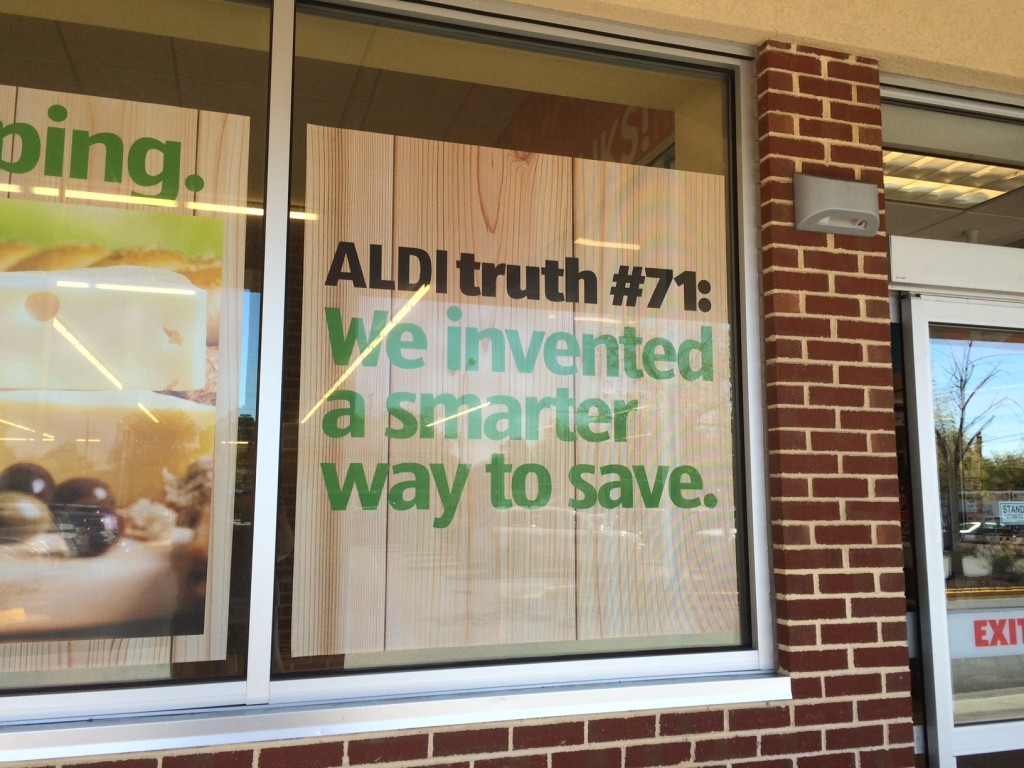
Recently, Supermarket News awarded Aldi USA with the 2015 Retail Achievement Award. This prize was awarded to honor Aldi’s exceptional achievement: Aldi USA has not only been able to increase its sales significantly, it has also served as an example for American retail.
I can only smirk at the title of my own entry. It’s actually not something that I came up with, but something from the American trade press. I’m smirking, because Aldi in the USA isn’t any different from Aldi in Germany: the stores look the same, aren’t any bigger than they are in Germany, and they offer a lot of basic groceries, a small selection of fruits and vegetables, and have an aisle with special offers. It doesn’t exactly sound exciting!
How is Aldi “Made in the USA”?
What Aldi has done, is to adapt its range of products. There is a large variety of cereals and chips in the grocery section, but I haven’t seen any flour or sugar. The refrigerated section has room for a palette of milk, which is a dollar cheaper at Aldi than at Walmart. One gallon costs $3.52 at Walmart, whereas Aldi sells it for just $2.59. You won’t find any asparagus in the produce section, but there are plenty of cooking plantains and lots of corn. Lastly, I’ve never seen clothing for sale in the special offers aisle, which may be due to the fact that clothing is less expensive in the US than in Germany.
Aldi USA isn’t as Camera shy as in Germany
One event to highlight is the interview with Jason Hart, CEO of the US daughter company. Aldi is known for being media shy. In my more than 20 years in Germany, I can’t remember a single interview. Just shortly before his death in 2014, the last surviving founder of Aldi, Karl Albrecht, finally granted the Frankfurter Allgemeinen Zeitung a glimpse into his world. This made me all the more surprised to read a lengthy article with plentiful quotes from the American manager.
According to Supermarket News (the German equivalent is Lebensmittel Zeitung), Aldi has re-invented the American discount market, even though it generates lower volumes. Aldi presents a real threat for Walmart.
“Over the last 15 years, Aldi has gone from attracting that income-constrained customer who needed to shop for the lowest-price groceries, and evolved so that stores are more pleasant, more open and brighter. They’ve evolved merchandise assortments to be more trend-right. And that’s widened the customer base from people who need to save money, to more of a smart shopper who wants to save money”.
One Point of Criticism: Service
When I posted my first blog post about Aldi to Twitter, I ended up spending a few days exchanging tweets with an American, who was decidedly not a fan of Aldi. Her main point of criticism probably rings true for many Americans: the lack of service. Not everyone is happy with having to have a quarter at the ready to access the shopping carts. Many don’t care for the smaller selection of goods. Others dislike being checked out at the register at lightning fast speeds. Aldi can’t be everything for everyone, but even so, it’s gaining more and more customers in the US.
German Discipline, Even in the USA
In Supermarket News, Hart revealed the recipe for Aldi’s success in the USA: DISCIPLINE! Discipline in staying true to the policy of offering the lowest price, high quality, and simple presentation and discipline in selecting products. By discipline, Hart means sticking to a concept and maintaining uniqueness. In contrast to the traditional American discount stores, Aldi has always maintained this: a core selection with tidy shelves and no products with expired sell-by dates.
Aldi has developed further in the last 40 years that it’s existed in the US. The stores have become friendlier and Aldi USA now offers more fruits and vegetables than before. Even organic products have found their ways onto Aldi’s shelves. Next to the organic products, Aldi also stocks gluten-free varieties, premium products (e.g. Soppressata, a type of Italian sausage), and natural products without additives. Additionally, there are non-food items, called “Special Buys”. This should all sound familiar to Germans, since there is really no difference from the German markets.
One Should Not Speak of Numbers
One thing that’s not at all any different from Aldi in Germany and that is the silence surrounding solid numbers. Hart has only shared some information, for example, that the new stores are about 10% larger (up to 11,000 square feet.) and so have more room for more articles. Currently, an Aldi store carries an average of 1,350 SKUs.
The following numbers are estimates from Supermarket News. The average Aldi store brings in $150,000 a week, with an average purchase by customers around $53. To compare, Aldi Süd has 1,850 stores and generated € 15.5 billion in 2014, which comes to about €160,000 a week. This morning, the exchange rate was about $1.12 to €1. With the exchange rate in mind, average sales were about 20% higher in Germany than in the USA.
Oktoberfest at Aldi
I’ve reported several times on Aldi and Lidl in the US. Two years after moving to the US, I still go shopping at Aldi on occasion. After being away for six months, I went there last Friday and filled my shopping cart with all sorts of German cuisine products: Weisswurst (a Bavarian sausage), Nürnberger (thin and short sausages from the Nürnberg region), Spätzle (egg noodles), Erdnuss Flips (essentially peanut-flavored Cheetos), and Jaffa cakes. Aldi was advertising Oktoberfest Week. There wasn’t any beer, but there were giant hard pretzels and sweet mustard. Near the German Bundeswehr campus in Reston, Virginia, they are apparently already sold out through Thursday evening. Prosit, Aldi!





http://urbanplacesandspaces.blogspot.com/2011/11/thanksgiving-and-food-roundup-in-honor.html
Sorry, meant to include this link to the past blog entry where I referenced the Post story.
It truely has revolutionized the American Discount Business. A few years ago, Aldi was just a store. These days many Americans enjoy shopping at Aldi, because it is not like the other grocery stores. The stores appear to be a little different than in Germany, but the strategy of Aldis is the same. This could turn into a success story for Aldi.
Wait & see. Lidl could be a real threat if it succeeds to stick to the German discount grocer concept, and to be more aggressive at the same time.
I don’t think Lidl will be a real threat. And competition is healthy. We have the same situation in Germany where Aldi and Lidl both exist and both have big shares in the market, but I wouldn’t say that they have the exact same concept therefore they Lidl will not really threaten Aldi. Also, I think in America, Aldi has an advantage simply, because it’s already established in the market these days. It will take a few years before Lidl reaches that same level of trust…
The country is big enough to have both. Aldi takes it seriously: right now many stores are getting a new look. I’ll post a video someday…
I only know the stores in the DC area. I don’t think people “enjoy” shopping at them. The majority of people who shop there are probably lower income and appreciate the deep savings, and are willing to withstand long lines and limited number of active checkouts in return for significantly lower prices.
But when the Aldi opened in DC, one of the comments in the article in the Washington Post was from a lower income resident who made the point that access to cheaper food is just as important as access to higher priced food, like from Whole Foods.
It made me realize that in urban planning and retail planning, in aiming to deal with supermarketing issues and food access, that price points are an issue and should be addressed in a systematic way. To wit, encourage the opening of Aldi, Savalot, Lidl, as well as Trader Joe’s, Whole Foods, Wegmans, etc.
Exactly! I was “shocked” at the prices after doing my first grocery shopping, and I wouldn’t say that food in restaurants is cheap. If you want to eat well, to enjoy a good meal in the US (my French part takes over right now!), you have to pay more than for a burger!
Aldi sells baking products in the US. That’s where I buy flour and sugar. I don’t know Germany very well. I would think the difference in sales between markets has to do with differences in urbanism vs. suburbanism. The US market for groceries generates more sales in the suburbs. And since incomes are generally higher in the suburbs, people might be a little less interested in shopping at a place like Aldi. In the cities, they aren’t located in central locations the way they are in Germany.
Of course, Aldi’s acquisition of stores in Philadelphia will change things a bit, at least in that market. They will function spatially in a situation more like cities in Germany probably.
Thank you Richard. I highly appreciate your comment, and of course, you are right with flour and sugar. I oversaw it during my last shopping.
The location strategy followed by Aldi USA reminds me Aldi in Germany 20 years ago. In the 90’s, they were still in “poorer” suburbs. Now, they are everywhere. Aldi stores in downtown are smaller and have no parking for example. In Wiesbaden, the city I used to live before moving to the States, Aldi in downtown was always busy.
Aldi USA is expected to open new stores in California next year. Some says with larger stores and other products, more targeting on the Hispanic customers. I doubt it. Aldi’s success is based on exporting straight, efficient, process, not on adapting for a certain type of customers. Wait and see!
Well, I was really struck by your point in the original article that what distinguishes the company is it’s discipline. … although interestingly, I had a comment from a German on my blog wrt Aldi and he says that Aldi Nord isn’t run very well. As you know, the stores in the US are run by Aldi Sud.
Given that Hispanic shoppers are driven by price (you living where you do in NoVA aren’t likely to come across a traditional Hispanic market in your area, while most items are priced too high for my tastes, produce is usually well priced) and could be a great source of customers in SoCal especially, I could see the company putting in some extra Hispanic items.
There is a limited selection of Hispanic items (tortillas, masa flour, tortilla chips, etc.) at the store in DC.
Personally, for CPG type goods, generally we aren’t satisfied by the quality of Aldi items, and don’t even experiment buying them anymore. E.g., their tortillas are very “doughy” and not worth buying, despite the seemingly great price.
But produce, canned beans and olives, mustards, cream cheese, flour and sugar and certain spices, etc., I gladly buy at Aldi, saving a lot of money in the bargain.
I have only been to Germany once, and too briefly. I wasn’t able to check out an Aldi even though I passed by one in Hamburg. I did shop at a Lidl at the train station in Essen, and at a Penny near the Hamburg train station.
I was “shocked” at my experiences in grocery stores there. I’d expected, and I know that all of those stores are deep discount, but also at other places, that food prices would be uniformly high, given what I’ve read about the market there. But I guess the place where food is “expensive” compared to the US, is in restaurants, while food at groceries is reasonable priced.